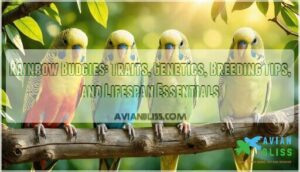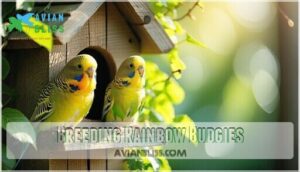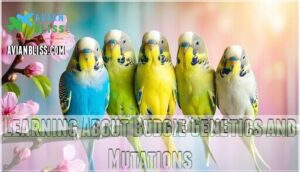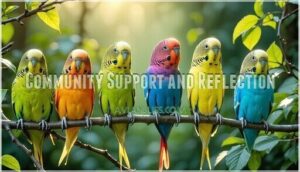This site is supported by our readers. We may earn a commission, at no cost to you, if you purchase through links.
 If rainbow budgies were a fruit, they’d be a tropical punch—bold colors, unique genetics, and plenty of sass.
If rainbow budgies were a fruit, they’d be a tropical punch—bold colors, unique genetics, and plenty of sass.
Their lifespans can range widely, depending on diet and genetics, so they need thoughtful care.
Breeding rainbow budgies isn’t just a roll of the dice; it takes research, good genes, and a watchful eye for non-sibling pairs.
These birds mix traits like single factor violet in females and a lively temperament, making each one a living kaleidoscope.
While their beauty might steal the show, what really matters is smart, responsible breeding.
Ready to uncover more secrets of these feathered rainbows?
Table Of Contents
- Key Takeaways
- Characteristics of Rainbow Budgies
- Gender-specific Traits (e.g., Single Factor Violet in Females)
- Breeding Rainbow Budgies
- Learning About Budgie Genetics and Mutations
- Factors Affecting Budgie Lifespan
- Community Support and Reflection
- Frequently Asked Questions (FAQs)
- How much does a rainbow Budgie cost?
- What is a rainbow Budgie?
- How do budgies get a rainbow?
- Are rainbow budgies a budgerigar?
- Do Rainbow budgies come in different colors?
- Where can I get a rainbow Budgie?
- What are rainbow budgies?
- How to get rainbow budgies?
- Do rainbow budgies exist?
- What is the ideal environment for rainbow budgies?
- Conclusion
Key Takeaways
- You’ll keep rainbow budgies healthy by focusing on a varied diet, solid genetics, and vet care over flashy looks.
- Don’t skip your homework—ethical breeding and genetic diversity protect against health issues and short lifespans.
- You’ll uncover genetic quirks like single factor violet in females, making every rainbow budgie uniquely colorful.
- Reliable online communities and avian vets give you practical support, real-world advice, and help when you run into challenges.
Characteristics of Rainbow Budgies
A rainbow budgie’s feather pigments are a party of color mutations and unique combinations.
A rainbow budgie is nature’s own confetti burst, each feather flaunting its own dazzling celebration of color mutations.
These composite variety birds are like living rainbows, showing off cobalt blues, soft yellows, and all sorts of splashy blends thanks to years of budgie mutations and careful breeding.
Identifying traits include patches of greenish, violet, or yellow tones—a color palette Picasso would envy. Don’t be surprised if no two rainbow budgie features look alike; each bird’s genetic mutations mix up a one-of-a-kind masterpiece.
These vibrant colors, much like the scarlet macaw’s display, aid in communication.
Gender-specific Traits (e.g., Single Factor Violet in Females)
You’ll notice female budgies exhibit a more pronounced Single Factor Violet coloration.
This sex-linked mutation affects feather color, with females showing more intense violet hues.
Understanding these genetic differences, like Male Color Intensity, is key to breeding.
The Female Violet Factor plays a significant role in budgie mutations and color mutations, including violet.
This difference in coloration may be linked to sexual selection pressures.
Breeding Rainbow Budgies
You’re about to start breeding rainbow budgies, which requires careful planning and research.
By understanding the genetics and traits of these birds, you’ll be able to make informed decisions and breed healthy, vibrant rainbow budgies.
Importance of Extensive Research and Preparation
Now, let’s talk about breeding rainbow budgies. First, you’ve got to do your homework. Breeding preparation is key. It’s more than just putting two birds together!
- Research budgie breeding techniques.
- Boost your genetic knowledge.
- Do health research.
- Understand dietary needs.
Talk to an avian vet. Understand the breeding process and challenges. Responsible budgie breeding avoids careless practices that impact their health. Selective breeding can be tricky!
Confirmation of Non-sibling Status From The Breeder
When breeding rainbow budgies, you often verify the birds’ non-sibling status with the breeder to guarantee Breeder Transparency and Genetic Diversity, avoiding inbreeding for healthier offspring through Ethical Breeding practices.
You may also need to purchase budgie breeding supplies for the birds.
Diverse Genetic Pool and Responsible Breeding Practices
To keep your rainbow budgies healthy, focus on genetic diversity and responsible bird breeding.
- Why? A wide genetic pool helps prevent inherited diseases.
Ethical breeding sometimes involves understanding unique bird breeding habits.
Choose breeders who prioritize budgie genetics and health screening.
Ethical breeding means avoiding extreme genetic mutations that can harm your birds.
Lineage tracking is also key.
Understand mutation risks and use selective breeding wisely.
With responsible practices, you’ll help your rainbow budgies thrive.
Commitment to Continuous Learning and Responsible Breeding
You’re building on responsible breeding practices, now focus on continuous learning.
Stay updated on genetic research, understand mutations, and seek community guidance.
Ethical budgie breeding requires genetic diversity importance awareness, utilizing breeding education resources and community learning support for rainbow budgies, budgie genetics, and selective breeding.
Learning About Budgie Genetics and Mutations
You’re about to learn how budgie genetics and mutations work, which is essential for understanding these colorful birds.
By studying genetics, you’ll gain insight into the unique traits and characteristics of rainbow budgies, helping you make informed decisions about their care and breeding.
Study Areas for Understanding Budgie Genetics
When diving into bird genetics, you’ll need to juggle a rainbow of topics—pun intended.
Understanding color mutations, tracking recessive genes, and using a budgie mutation calculator will help you unravel avian genetics.
Pay attention to:
- Genetic diversity and inbreeding
- Eumelanin/pheomelanin pigment roles
- Selective breeding practices
- Health impacts of specific genetic mutations
Understanding budgie base colors is essential for predicting offspring coloration.
Seeking Confirmation and Guidance From Online Communities
With a flock of budgie enthusiasts just a click away, seeking Online Validation from reputable communities sharpens your eye for mutations and improves budgie care.
You’ll find Community Expertise invaluable—just remember proper Forum Etiquette when Seeking Advice! Reliable budgie breeders boost your confidence and learning curve.
Don’t be shy; even the best rely on shared Budgie Information to spot rare Rainbow Budgies. Healthy banter about Breeder Reputation can help guide decisions.
A great resource for this is the Audubon Bird Guide.
Here’s what you’ll enjoy:
- Quick answers to tricky genetics questions
- Case studies on Budgie Health
- Networking with experienced breeders
- Feedback on identifying Rainbow Budgies
- Honest tales of budgie breeding wins—and mishaps
Appreciation for Community Responses and Corrections
As you soak up wisdom from forum insights and shared experiences, you’ll quickly realize the Budgerigar community is a goldmine.
You’re never flying solo—someone’s always there to offer genetic guidance or a gentle correction.
These real stories, often mixed with a bit of humor (and maybe a “rainbow budgies ate my homework” tale), spark continuous learning.
Here’s a heartfelt nod to those who trade tips and Vet Recommendations, turning colorful genetic mutations into understanding, not just varieties.
| What You Get | How It Helps You |
|---|---|
| Vet Recommendations | Better health outcomes |
| Forum Insights | Smarter daily care |
| Shared Experiences | Fewer beginner mistakes |
| Genetic Guidance | Clearer color results |
| Continuous Learning | Happy, thriving budgies |
Factors Affecting Budgie Lifespan
You’ll find that a rainbow budgie’s lifespan depends on more than luck—diet, genetics, and daily care all play major roles.
If your budgie could read nutrition labels, it might remind you that even the most colorful birds need more than just pretty feathers to stick around for years.
Variability in Budgie Lifespans
Understanding Rainbow Budgies’ lifespans means looking at more than just numbers. Factors like Genetic Predisposition and bird lifespan quirks make every budgie unique.
You might find some live for five years, and others, with the right care, keep on singing past their tenth hatchday.
To boost your budgie’s chances:
- Prioritize Diet Quality
- Improve Cage Environment
- Keep up with Veterinary Care
- Encourage daily Exercise Impact
- Consider genetic mutations affecting budgie lifespan
Every feather counts!
Influence of Diet and Breeding Practices on Lifespan
It’s amazing how much a solid budgie diet shapes your bird’s years.
Stick with just seeds, and you’re looking at a lifespan factor dropping to 4–8 years.
Step up the bird diet with pellets, fresh veggies, fruits, and some egg, and watch those lifespan odds climb.
Ensuring a balanced diet can be achieved through high-quality food pellets.
But here’s the rub—breeding ethics matter too, as some breeders focus only on flashy colors, ignoring genetic diversity and real Health Monitoring.
That shortcut means even the best bird nutrition won’t rescue a two-year budgie, so Choose wisely!
Impact of Genetic Strength and Availability of Genetically Strong Budgies
Not all rainbow budgies are created equal.
If breeders chase wild color mutations over genetic diversity, weak genetics can sneak in.
When bird breeding leans more on looks than breeding ethics, inbreeding and low diversity show up—think health hiccups and shorter lives.
For a long-lived buddy, ask avian breeding pros about mutation prevalence, genetic strength, and conservation concerns before you choose.
Potential Health Issues Associated With Rainbow Budgies
Dodging troubles like a feathery ninja, your Rainbow Budgie can still stumble into a few common health potholes.
Keep an eye out for these five headliners:
- Respiratory Problems—sneezing or wheezing isn’t just bird gossip.
- Feather Plucking—sometimes it’s nerves, sometimes bird fashion faux pas.
- Megabacteria Infection—sounds epic, hits hard.
- Bacterial Infections—especially in pesky young flocks.
- Genetic Predispositions—sometimes, they just draw the short straw.
Budgies are also prone to nutritional deficiencies, so a balanced diet is key.
A savvy avian vet makes all the difference in avian health.
Historical Perspective on Budgie Longevity
A quick stroll down memory lane shows that Early Budgie Lifespans looked much different than today’s. Back then, your Melopsittacus undulatus pals relied mostly on seed mixes—pellets were a luxury, not the norm.
You might think regular flying was just a bird’s pastime, but it was a game-changer for bird health and longevity. Breeding Impact Longevity was front and center: fewer folks were focused on fancy colors, keeping genetic diversity decline in check.
As breeding trends shifted toward looks rather than strength, some baby budgies started drawing the short straw in the genetics lottery. Limited pellet options meant historical diet factors kept lifespans a bit short.
- Plenty of exercise gave birds an edge—flying keeps those wings and spirits strong.
- Less inbreeding meant healthier families and pets.
- Veterinary Care History was sparse, so many budgies didn’t get the checkups yours do now.
- Limited pellet options meant historical diet factors kept lifespans a bit short, highlighting the importance of proper nutrition.
Community Support and Reflection
You won’t have to navigate the sphere of rainbow budgies alone, thanks to supportive online communities and local networks ready with advice and resources.
Sometimes, finding a good avian vet or learning from others’ funny bird mishaps can be just as helpful as a genetics chart.
Importance of Community Support in Finding an Avian Vet
You never know when a feathered friend might need emergency avian care, so it pays to have an avian vet on speed dial.
Local bird groups and online vet reviews are gold mines for bird health tips and finding specialists.
Folks in those spaces share experience, laughter, and practical stories. Need a bird care tip or a referral? Someone always knows a vet with just the right knack.
Checking a bird vet directory can also provide valuable options. With a nod to community wisdom and real-world advice, you’ll avoid “winging it” when bird health is on the line.
Gratitude for Online Forums and Information Sharing
Finding an avian vet is just the first step.
Tap into the online forum benefits where Rainbow Budgies and budgerigars become more than just pets—they’re reasons to connect.
Community knowledge access means bird enthusiasts, from first-timers to experts, trade bird care tips and real-world solutions faster than a flock can scatter.
The information sharing impact is huge: one question answered can help dozens more, with expert advice value that’s invaluable, like finding the ripest millet at your favorite online store, which provides real-world solutions.
Try it—you’ll learn plenty from others.
Reflecting on The Vulnerability and Small Size of Budgies
Rainbow budgies pack a big personality into a tiny package.
Bright feathers, bold spirit—these little birds are proof that the best things come feather-sized.
Their fragile nature means even minor bumps can lead to big problems.
Environmental dangers lurk everywhere, so predator awareness and handling caution are daily musts for any budgerigar owner.
The emotional impact of caring for small, sensitive pet birds reminds you that avian companions deserve the best bird care—every single day, which requires constant awareness of their needs.
Sharing Personal Experiences and Lessons Learned
As you get to know your First Budgie, you’re bound to encounter surprises that leave you both scratching your heads.
Here’s what fellow rainbow budgie owners have discovered:
- Health scares have everyone running for an avian vet—turns out, those cheerful budgie colors can’t scare off a cold.
- Taming challenges pop up; some birds act like feathered Houdinis.
- Diet discoveries are real—yes, your budgie really will spit veggies at you.
- Breeding regrets? Sometimes, two bonded birds scatter feather drama everywhere.
Sharing stories helps everyone handle bird bonding and unique bird behavior.
Encouraging Others to Prioritize Budgie Health and Proper Care
Sometimes, it’s the smallest creatures that require the biggest commitment.
To keep your rainbow budgies thriving, cover these basics:
- Dietary Needs: Offer a mix of seeds, fresh veggies, and pellets for a balanced avian diet.
- Cage Environment: Clean, spacious, and full of stimulating toys.
- Vet Checkups: Schedule regular visits for preventive health.
- Mental Stimulation & Social Interaction: Chat, play, and let them explore.
Reliable budgie care builds a happy, healthy flock—no feathered complaints!
Frequently Asked Questions (FAQs)
How much does a rainbow Budgie cost?
Barking up the right tree for a rare bird? You’ll shell out $50 to $400 for one.
Prices depend on age, coloring, and breeder reputation.
Don’t pluck your savings—shop around for healthy, happy budgies!
What is a rainbow Budgie?
Picture a parakeet dressed for a color run—these birds sport vibrant blues, yellows, and greens thanks to selective breeding.
You’ll spot unique patterns on each one, making every rainbow Budgie a living, squawking snowflake.
How do budgies get a rainbow?
Colorful budgies don’t just roll out of the paint shop—they strut their stuff thanks to breeders mixing genes like they’re making a secret smoothie.
Combine clearwing, opaline, and yellowface mutations and voilà: you’ve got a rainbow!
Are rainbow budgies a budgerigar?
Nearly 80% of pet birds in households are budgerigars, and you might be surprised—rainbow budgies are indeed a type of budgerigar.
They’re not a separate species, just showier cousins, thanks to selective breeding.
Do Rainbow budgies come in different colors?
You’ll spot these birds dressed in shades ranging from sky blues to sunlit yellows and even hints of violet or grey.
Breeders mix and match genes, so, yes, your feathered friend can strut a whole rainbow.
Where can I get a rainbow Budgie?
A sprinkle of rainbow in your home starts at specialty pet stores, reputable bird breeders, or avian rescue groups.
Check breeder reviews, ask about genetic backgrounds, and make sure your feathery friend’s wings come with a real birth certificate.
What are rainbow budgies?
You’ve met rainbow budgies: tiny birds with wild, vivid colors thanks to selective breeding.
They’re lively, social, and definitely crowd favorites in the bird world.
Think of them as living Skittles—only these sweethearts chirp and climb.
How to get rainbow budgies?
Think of it like building a custom pizza—pair budgies with clearwing, opaline, and yellowface genes for rainbow results.
Track parent genes, avoid inbreeding, and be patient; those vibrant, feathered masterpieces take careful, data-driven planning.
Do rainbow budgies exist?
You’ll find rainbow budgies are very real—just not in the wild.
Breeders use genetic recipes to create their dazzling colors.
So yes, you can get one, but you won’t catch them perched in Aussie outback trees!
What is the ideal environment for rainbow budgies?
Imagine your living room as a penthouse—your bird wants space, not a shoebox.
Choose a roomy cage with horizontal bars, natural perches, good airflow, and sunlight but no drafts.
Toys? Absolutely—boredom’s a real villain.
Conclusion
Like living confetti, rainbow budgies brighten your life with color, character, and curiosity.
You’ve learned their genetics aren’t just a paint-by-numbers.
Responsible breeding, careful diet, and community insights all help you keep your feathered friends healthy.
Remember, data and research matter when managing their lively personalities and potential health challenges.
Keep your local avian vet’s number close and your curiosity closer.
With the right care, your rainbow budgies’ brilliance can shine for years to come.
- https://www.youtube.com/watch?v=-4Ij-DHHwMs
- https://www.sciencedirect.com/topics/agricultural-and-biological-sciences/budgerigar
- https://www.ncbi.nlm.nih.gov/pmc/articles/PMC5951300/
- https://journals.tdl.org/watchbird/index.php/watchbird/article/download/2845/2829/0
- https://www.al-nasser.co.uk/article1.htm







